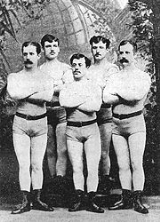
Hanlon-Lees
Encyclopedia

Acrobatics
Acrobatics is the performance of extraordinary feats of balance, agility and motor coordination. It can be found in many of the performing arts, as well as many sports...
founded in the early 1840s, the Hanlon-Lees were world-renowned practitioners of "entortillation" (an invented word based upon the French term entortillage, which translates to "twisting" or "coiling") – that is, tumbling, juggling, and an early form of "knockabout" comedy (later popularized by such groups as the Marx Brothers and the Three Stooges). The troupe consisted of the six Hanlon brothers and their mentor, established acrobat Professor John Lees.
Originally billed as "The Hanlons," the group debuted in 1846 at London's Theatre Royal, Adelphi
Adelphi Theatre
The Adelphi Theatre is a 1500-seat West End theatre, located on the Strand in the City of Westminster. The present building is the fourth on the site. The theatre has specialised in comedy and musical theatre, and today it is a receiving house for a variety of productions, including many musicals...
. At this time, the company consisted of George, William, and Alfred Hanlon, who were essentially wards of John Lees until his death in 1855. After his demise, the Hanlons returned to England and enlisted their younger brothers – Thomas, Edward, and Frederick – and rechristened themselves "The Hanlon-Lees" in honor of their fallen friend and instructor.
The newly expanded troupe made its American debut in 1858 at Niblo's Garden
Niblo's Garden
Niblo's Garden was a New York theatre on Broadway, near Prince Street. It was established in 1823 as "Columbia Garden" which in 1828 gained the name of the Sans Souci and was later the property of the coffeehouse proprietor and caterer William Niblo. The large theatre that evolved in several...
in New York City, and spent the next four decades touring the United States and Europe. As their skills improved, their performances became more elaborate. When Jules Léotard introduced the trapeze in 1859, for instance, the Hanlon-Lees quickly adapted to the new device; their next production, Le Voyage en Suisse (A Trip to Switzerland) contained an aerial juggling sequence that stunned Emile Zola
Émile Zola
Émile François Zola was a French writer, the most important exemplar of the literary school of naturalism and an important contributor to the development of theatrical naturalism...
, who expressed utter astonishment at the vast number of airborne objects. There is a spectacular poster by Jules Chéret, the great pioneer of the classic era of French poster design, advertising their appearance at the Folies Bergères in 1878.
The Hanlon-Lees also patented several inventions, including the aerial safety net and a wooden brace used in the construction of scenery (which is to this day referred to as a "hanlon
Hanlon
Hanlon is a surname often associated with, but not necessarily tied to, the O'Hanlon Sept. The name may denote:* Jim Hanlon American-born lawyer* Alfred Hanlon, British-born acrobat * Alfred Charles Hanlon, New Zealand lawyer...
").
Despite the death of Thomas in 1868, the group continued to perform regularly until the early 1900s, at which point George Hanlon's sons Will and Fred assumed control of the company's repertoire. They would carry the company successfully into the 20th Century, going so far as to appear on film for Thomas Edison
Thomas Edison
Thomas Alva Edison was an American inventor and businessman. He developed many devices that greatly influenced life around the world, including the phonograph, the motion picture camera, and a long-lasting, practical electric light bulb. In addition, he created the world’s first industrial...
in a production entitled Fantasma. The Hanlons would endure for another four decades, adapting their acts for vaudeville and finally appearing in the 1945 season of the Ringling Brothers and Barnum & Bailey Circus.
In 1979, six American performers sought out the final living descendant of the original Hanlon brothers and asked for her blessing upon their new company, dubbed the Hanlon-Lees Action Theater
Hanlon-Lees Action Theater
Hanlon-Lees Action Theater is an American entertainment company credited with the development of theatrical jousting. The company was formed in 1979 by partners Kent Shelton, Robin Wood, Richard "Dikki" Ellis, R. Vincent Park, Taso N...
. This modern incarnation of the original troupe is best known for pioneering and refining a theatrical form of medieval jousting, an event which the company continues to perform at Renaissance festivals in the United States. The modern day Hanlon-Lees also perform Western-themed shows such as fantasy rodeos and cowboy exhibitions.

